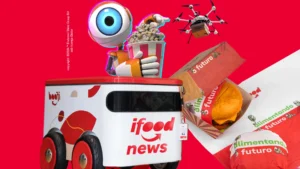Who said that human beings cannot have computers as creative partners?
Would a computer make a good pair for those looking for partners to expand their creativity? With the use of artificial intelligence (or AI), yes, points out Sandor Tucakov Caetano, chief data scientist at iFood.
This is because artificial intelligence is a different way of programming a computer to do some tasks that we consider intelligent, such as reading, writing or recognizing a person, explains the expert.
Instead of making the machine obey a programming code, the idea is to create programs that are capable of analyzing a large volume of data to solve the problems or challenges that are proposed. “We tell the machine how it has to learn, not what it should learn”, says Sandor.
He gives an example: passing thousands of photos of cats for artificial intelligence to break down into numbers and thus learn to recognize a cat image based on similarity. If fed with texts, the machine can also predict which word usually comes after another and thus write an entire sentence.
But there are still limits. “Being able to write doesn’t mean he understands what he’s doing,” Sandor ponders. Hence the importance of combining talents: the machine performs repetitive tasks and analyzes a huge volume of data and humans provide the qualitative touch. “Working with artificial intelligence is an opportunity for us to use our creativity to the extreme,” says Sandor.
Want to know how? He highlights three cases in which this partnership is already bearing fruit:
Improv Challenge
In London, a troupe of actors takes the stage to perform improv comedy with a different colleague at the Imrobotics. One chatbot With artificial intelligence it sends phrases to the comedians via headphones and they have to manage to make the audience laugh with what was proposed by the machine.
Meanwhile, behind the stage, an operator types sentences and sends them to the chatbot, which in turn generates new sentences for the improvisers to create their show in front of the audience (who don't know which of the comedians is receiving the phrases from the chatbot). Even the show's host is a robot, which also uses artificial intelligence to interact with the actors. “The computer generates the motto, but someone needs to give meaning and emotion to the text”, comments Sandor.
A new whiskey recipe
To innovate in whiskey flavors, the Swedish distillery Macmyra decided to explore artificial intelligence. The brand created a database with all its recipes (including award-winning ones), sales numbers and consumer preferences. With this information, artificial intelligence was used to make the best combinations and suggest new recipes taking into account the public's taste and the barrels that were available at the distillery.
After generating more than 70 million recipes, artificial intelligence predicted which ones would be most popular and of the best quality and arrived at some finalists, which were curated and tasted by master blender Angela D'Orazio, who supervised the entire process. This is how the single malt came about Intelligence, which had a score above the average for the company's portfolio, points out Sandor. “The recipe was created by artificial intelligence, but we still take advantage of human expertise and knowledge, especially in the sensory aspect, which can never be replaced by a program”, says Angela.
One game, several stories
At the AI Dungeon, the players' adventure is co-created with the game's artificial intelligence. After choosing a scenario and character to play online, players interact with this AI. At each step of the story, decisions must be made, which are typed into the computer. The program reads the action and proposes a continuation of the story.
In this way, each person creates a unique adventure in partnership with suggestions from artificial intelligence, which uses the information it receives to propose new challenges. “The narratives end up being so cool that they are inspiring writers to write their own stories,” says Sandor. “This is an example of a natural language processing model in which AI uses information to suggest new text.”


